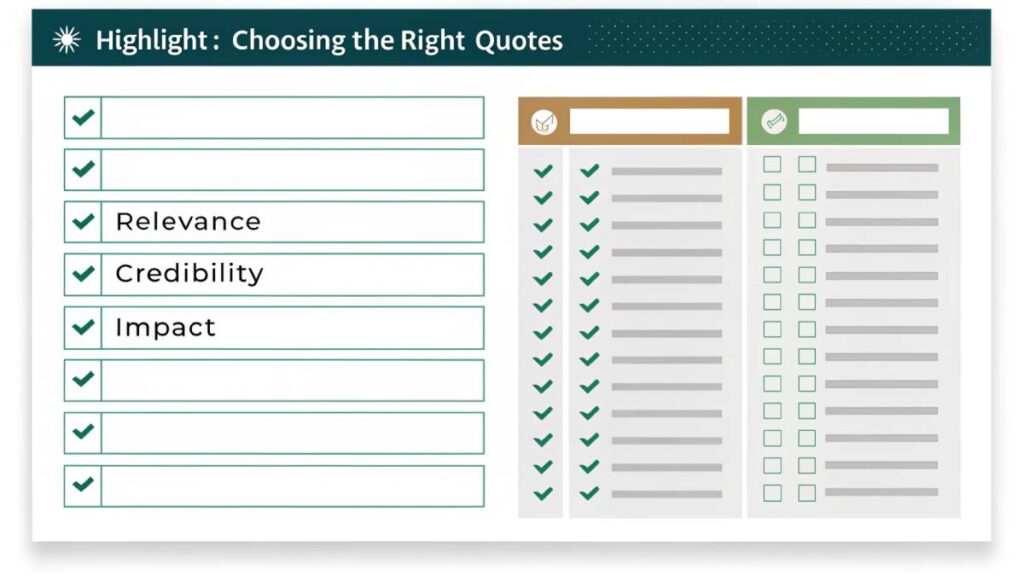Writing an essay is not just about presenting your ideas; it’s also about supporting them effectively.
One of the most powerful tools at your disposal is the use of quotes. Incorporating quotes into your essays can significantly enhance your arguments, add credibility, and demonstrate your engagement with the source material.
This article delves into the art of using quotes effectively, providing you with the strategies and best practices to seamlessly integrate quotations into your writing.
Importance of Using Quotes in Essays
Enhancing Credibility and Supporting Arguments
Quotes from reputable sources lend authority to your essay, making your arguments more persuasive. By referencing experts and established works, you demonstrate that your ideas are backed by credible evidence.
This not only strengthens your thesis but also reassures your readers that your arguments are well-founded.
Demonstrating Engagement with Source Material
Using quotes shows that you have thoroughly researched your topic and are actively engaging with existing literature. It reflects your ability to analyze and synthesize information, positioning you as a knowledgeable and thoughtful writer. This engagement is crucial for academic success and helps build a strong foundation for your arguments.
Guiding Students and Writers on Effective Quotation Usage
This article serves as a comprehensive guide for students and writers aiming to master the use of quotes in their essays. Whether you’re a high school student tackling your first research paper or a college student working on a thesis, understanding how to use quotes effectively is essential.
Providing Tips and Best Practices for Integrating Quotes Seamlessly
We offer practical tips and best practices to help you integrate quotes smoothly into your writing. From selecting the right quotes to formatting them correctly, this guide covers all aspects of quotation usage, ensuring that your essays are both compelling and academically sound.
Choosing the Right Quotes
Incorporating the right quotes into your essay can significantly enhance your arguments, add credibility, and engage your readers. However, selecting and utilizing quotes effectively requires careful consideration. This section delves into the key aspects of choosing the right quotes for your essay.

Relevance to Your Argument
Selecting Quotes That Directly Support Your Thesis
Every quote you include should serve a clear purpose in reinforcing your thesis statement. Begin by identifying the core arguments of your essay and seek out quotations that directly bolster these points.
For instance, if your essay argues that climate change is accelerating due to human activities, selecting a quote from a leading climate scientist can provide authoritative support.
Ensuring Quotes Align with the Essay’s Main Points
Alignment between your quotes and main points ensures coherence and strengthens your overall argument. Each quote should seamlessly integrate into your narrative, providing evidence or illustrating a concept you’ve introduced. Avoid inserting quotes that, while interesting, may divert attention from your primary arguments.
Example:
Thesis Statement: “Implementing renewable energy sources is essential for mitigating the adverse effects of climate change.”
Supporting Quote: “Renewable energy sources like wind and solar power are critical in reducing greenhouse gas emissions” – Dr. Jane Smith, Environmental Scientist.
Credibility of Sources
Choosing Reputable and Authoritative Sources
The credibility of your essay hinges on the reliability of your sources. Opt for quotes from established experts, peer-reviewed journals, and reputable publications. Academic journals, books from recognized authors, and official reports are excellent sources for authoritative quotes.
Evaluating the Reliability of the Information
Before incorporating a quote, assess the source’s reliability. Consider the author’s credentials, the publication’s reputation, and the date of publication to ensure the information is current and accurate. Avoid using quotes from dubious websites or sources with potential biases that could undermine your essay’s credibility.
Statistics on Source Credibility:
| Source Type | Credibility Level | Examples |
|---|---|---|
| Peer-reviewed journals | High | Nature, The Lancet, Journal of Climate |
| Academic books | High | Publications by university presses |
| Reputable news outlets | Medium-High | The New York Times, BBC, The Guardian |
| Blogs/Websites | Low-Medium | Personal blogs, unverified online articles |
Table 1: Credibility Levels of Various Source Types
Balancing Quantity and Quality
Avoiding Over-Reliance on Quotes
While quotes can strengthen your essay, overusing them may dilute your original voice and analysis. Strive for a balance where your ideas lead the narrative, and quotes supplement your arguments. A good rule of thumb is to use quotes sparingly and purposefully.
Prioritizing Impactful and Meaningful Quotations
Focus on incorporating quotes that offer significant insights or powerful evidence. Select quotations that are concise yet impactful, enhancing the depth of your analysis without overwhelming your essay.
Best Practices for Balancing Quotes:
- Use Quotes as Evidence: Let your quotes serve as supporting evidence rather than the main content.
- Integrate Quotes Smoothly: Blend quotes into your sentences to maintain a natural flow.
- Analyze Quotes: Always follow up quotes with your interpretation or analysis to demonstrate their relevance.
Formatting Quotes
Properly formatting quotes is crucial for maintaining clarity, adhering to academic standards, and avoiding plagiarism. This section outlines the key elements of quote formatting, including distinguishing between short and long quotes, understanding various citation styles, and mastering punctuation and attribution.
Short vs. Long Quotes
Defining Short (Fewer Than 40 Words) vs. Long Quotes
Understanding the distinction between short and long quotes is essential for appropriate formatting:
- Short Quotes: Typically fewer than 40 words, short quotes are integrated directly into your text.
- Long Quotes: Also known as block quotes, these exceed 40 words and are set apart from the main text.
Appropriate Formatting for Each Type
- Short Quotes: Enclosed in quotation marks and incorporated into your sentence. Example: According to Smith (2020), “renewable energy sources are pivotal in reducing carbon emissions” (p. 45).
- Long Quotes: Indented from the left margin, single-spaced, and without quotation marks. Example: Renewable energy sources like wind and solar power not only reduce greenhouse gas emissions but also promote sustainable economic growth. Their implementation is crucial for achieving long-term environmental goals.
– Dr. Jane Smith, Environmental Strategies for the Future (2020, p. 102)
Citation Styles
Different academic disciplines prefer specific citation styles. Understanding these styles ensures your quotes are properly credited and formatted.
Overview of MLA, APA, Chicago, and Other Citation Formats
| Citation Style | Commonly Used In | Key Features |
|---|---|---|
| MLA | Humanities (Literature, Arts) | Author-page number format; emphasizes authorship |
| APA | Social Sciences (Psychology, etc) | Author-date format; includes DOI for online sources |
| Chicago | History, Some Humanities | Footnotes/endnotes and bibliography; flexible for various needs |
| Harvard | Various Academic Fields | Author-date system; similar to APA with slight variations |
Table 2: Overview of Common Citation Styles
Specific Guidelines for Quoting in Each Style
- MLA: Use the author’s last name and page number in parentheses. Example: “Renewable energy sources are pivotal” (Smith 45).
- APA: Include the author’s last name, year of publication, and page number. Example: “Renewable energy sources are pivotal” (Smith, 2020, p. 45).
- Chicago: Utilize footnotes or endnotes with full source details. Example: “Renewable energy sources are pivotal.”¹ ¹ Jane Smith, Environmental Strategies for the Future (New York: Green Press, 2020), 45.
Punctuation and Attribution
Proper Use of Quotation Marks
Quotation marks signal to readers that the enclosed text is a direct quote. Use double quotation marks for primary quotes and single marks for quotes within quotes.
Example: Smith stated, “The term ‘renewable energy’ encompasses various sources” (2020, p. 45).
Incorporating Citations and Attributive Tags Correctly
Attributive tags (e.g., “according to Smith”) introduce quotes and provide context. Proper placement of commas, periods, and other punctuation marks is essential.
Guidelines:
- At the Beginning: Example: According to Smith (2020), “renewable energy sources are pivotal” (p. 45).
- At the End: Example: “Renewable energy sources are pivotal” (Smith, 2020, p. 45).
- Middle of a Sentence: Example: Renewable energy sources, “are pivotal in reducing carbon emissions” (Smith, 2020, p. 45), and play a crucial role.
Common Punctuation Rules:
- Periods and commas go inside the quotation marks. Correct: “Renewable energy is essential,” she stated. Incorrect: “Renewable energy is essential”, she stated.
- Colons and semicolons go outside. Correct: She emphasized the importance of renewable energy: “It is essential for our future.” Incorrect: She emphasized the importance of renewable energy: “It is essential for our future”.
Avoiding Common Punctuation Errors:
Ensure that the punctuation does not disrupt the flow or clarity of the quote. Misplaced punctuation can alter the meaning or readability of the quoted material.
Choosing and formatting quotes effectively is a cornerstone of strong essay writing. By selecting relevant, credible quotes and balancing their quantity and quality, you can enhance your arguments and engage your readers.
Understanding the nuances of formatting, whether distinguishing between short and long quotes or adhering to specific citation styles, ensures your essay maintains academic integrity and clarity.
Mastering these skills will not only improve the quality of your writing but also demonstrate your ability to engage thoughtfully with source material.
Integrating Quotes into Your Writing
Effectively integrating quotes into your essay is crucial for maintaining a smooth narrative flow and reinforcing your arguments. Proper integration ensures that quotes enhance your writing rather than disrupt it. This section explores strategies for introducing quotes, blending them with your analysis, and maintaining your unique voice throughout your essay.
Introducing Quotes
Using Signal Phrases and Introductory Clauses
Signal phrases and introductory clauses are essential tools for seamlessly incorporating quotes into your essay. They provide a bridge between your ideas and the quoted material, preparing the reader for the upcoming information.
- Signal Phrases: These phrases attribute the quote to its original author and often include the author’s name and credentials. Examples:
- According to Dr. Jane Smith, “…”
- As noted by the Environmental Protection Agency, “…”
- In her study, Johnson states, “…”
- Introductory Clauses: These clauses set the context for the quote, explaining why it’s relevant to your argument. Examples:
- Given the increasing impact of climate change, “…”
- Considering the economic benefits, “…”
- In light of recent studies, “…”
Providing Context for the Reader
Contextualizing quotes helps readers understand their significance within your essay. Before presenting a quote, briefly explain its relevance to your argument.
Example:
Without Context: “Renewable energy sources are pivotal in reducing carbon emissions” (Smith, 2020, p. 45).
With Context: To emphasize the importance of sustainable practices, Dr. Jane Smith asserts, “Renewable energy sources are pivotal in reducing carbon emissions” (2020, p. 45).
Blending Quotes with Your Analysis
Ensuring Smooth Transitions Between Your Words and the Quote
Smooth transitions maintain the flow of your essay and prevent abrupt shifts when introducing quotes. Use transitional words and phrases to connect your analysis with the quoted material.
Examples:
- Furthermore, “…”
- Additionally, “…”
- Consequently, “…”
Analyzing and Interpreting the Quoted Material
Quotes should not stand alone; they require your analysis to demonstrate their relevance. After presenting a quote, explain its significance and how it supports your argument.
Example:
Quote: “Renewable energy sources are pivotal in reducing carbon emissions” (Smith, 2020, p. 45).
Analysis: This statement underscores the critical role that renewable energy plays in combating climate change, aligning with the essay’s thesis on the necessity of sustainable practices.
Maintaining Your Voice
Avoiding Abrupt Shifts in Tone
Maintaining a consistent tone ensures your essay remains cohesive. Avoid sudden changes in style or formality when incorporating quotes.
Example: Instead of abruptly shifting from a formal analysis to a casual quote, seamlessly integrate the quote within your established tone: “The transition to renewable energy is not only environmentally sound but also economically viable,” argues Smith (2020, p. 45).
Balancing Quoted Material with Original Content
A balanced essay blends your insights with supporting quotes. Ensure that your voice remains dominant, using quotes to enhance rather than overshadow your arguments.
Best Practices:
- Use quotes to support key points, not to make them.
- Limit the number of quotes to maintain originality.
- Ensure each quote serves a clear purpose in your narrative.
Avoiding Common Mistakes
Even with the best intentions, writers can fall into common pitfalls when using quotes in essays. Understanding these mistakes and knowing how to avoid them can significantly improve the quality of your writing.
Overusing Quotes
Risks of Excessive Reliance on External Sources
Relying too heavily on quotes can dilute your original ideas and make your essay seem like a compilation of others’ thoughts rather than your own analysis.
Implications:
- Reduced originality and personal voice
- Potential plagiarism issues
- Weaker argumentation due to lack of personal insight
Strategies to Maintain Originality
- Limit Quote Usage: Aim for a balance where quotes support, rather than dominate, your essay.
- Paraphrase When Appropriate: Restate information in your own words to demonstrate understanding.
- Focus on Key Quotes: Select only the most impactful quotes that directly support your thesis.
Table: Risks of Overusing Quotes vs. Strategies to Maintain Originality
| Risks of Overusing Quotes | Strategies to Maintain Originality |
|---|---|
| Diluted personal voice | Limit the number of quotes used |
| Potential plagiarism issues | Paraphrase when possible |
| Weaker argumentation | Use quotes to support key points |
| Reader disengagement | Focus on high-impact, relevant quotations |
Table 1: Balancing Quote Usage to Preserve Originality
Quoting Out of Context
Ensuring Quotes Are Accurate and Contextually Appropriate
Using quotes without proper context can misrepresent the original intent of the source, leading to confusion or misinterpretation.
Best Practices:
- Understand the Full Context: Before quoting, ensure you fully grasp the source’s meaning.
- Avoid Cherry-Picking: Select quotes that accurately reflect the source’s message without distortion.
- Provide Sufficient Background: Introduce quotes with enough information to convey their relevance.
Avoiding Misinterpretation or Distortion of Meaning
Ensure that the quotes you use accurately represent the original author’s intent. Misquoting or altering the context can undermine your essay’s credibility.
Example of Misinterpretation:
Incorrect: “Renewable energy is the only solution” (Smith, 2020, p. 45).
Original Context: Smith might have stated, “Renewable energy is one of the key solutions,” indicating it’s part of a broader strategy.
Neglecting Analysis
Importance of Explaining the Relevance of Each Quote
Every quote should be accompanied by an analysis that explains its significance and how it supports your argument. Without analysis, quotes can appear as standalone statements without contributing to your thesis.
Linking Quotes Back to Your Main Arguments
After presenting a quote, always tie it back to your main points to reinforce your essay’s overall narrative.
Example:
Quote: “Renewable energy sources are pivotal in reducing carbon emissions” (Smith, 2020, p. 45).
Analysis: This highlights the essential role of renewable energy in mitigating climate change, directly supporting the essay’s argument for sustainable energy adoption.
Paraphrasing vs. Quoting
Deciding whether to paraphrase or quote directly depends on the context and purpose of the information. Both techniques have their place in academic writing, and understanding when to use each can enhance your essay’s effectiveness.
When to Paraphrase
Situations Where Paraphrasing Is More Effective
Paraphrasing is ideal when you want to simplify complex information, emphasize a particular aspect, or integrate evidence smoothly into your narrative.
Examples:
- Summarizing background information
- Explaining detailed processes in simpler terms
- Highlighting a specific point from a broader argument
Benefits of Restating Information in Your Own Words
- Demonstrates Understanding: Shows that you comprehend the source material.
- Maintains Flow: Integrates information seamlessly into your writing style.
- Avoids Overuse of Quotes: Keeps your voice prominent in the essay.
Example:
Original Quote: “Renewable energy sources are pivotal in reducing carbon emissions” (Smith, 2020, p. 45).
Paraphrased: Smith (2020) emphasizes that renewable energy plays a crucial role in lowering carbon emissions.
When to Quote
Instances Where Direct Quotes Are Necessary
Direct quotes are essential when the original wording is particularly impactful, when the author’s exact phraseology is important, or when you need to reference specific terminology.
Examples:
- Highlighting a key statement or definition
- Preserving the original emphasis or style
- Presenting evidence that requires precise wording
Preserving the Original Wording for Impact
Some ideas are best conveyed through the author’s exact words to maintain their intended impact and authenticity.
Example:
Quote: “The only limit to our realization of tomorrow is our doubts of today” (Franklin D. Roosevelt).
Balancing Both in an Essay
Combining Paraphrasing and Quoting for a Cohesive Argument
A well-rounded essay utilizes both paraphrasing and direct quotes to support its arguments. This balance ensures that your writing remains original while effectively incorporating authoritative voices.
Strategies:
- Use Paraphrasing for General Points: Summarize broader ideas in your own words.
- Reserve Quotes for Key Statements: Incorporate direct quotes for pivotal evidence or impactful statements.
- Blend Both Techniques: Alternate between paraphrased information and direct quotes to maintain variety and engagement.
Techniques for Seamless Integration
- Introduce with Signal Phrases: Smoothly transition between your analysis and the quoted or paraphrased material.
- Ensure Logical Flow: Arrange paraphrased and quoted content in a way that supports your argument logically.
- Maintain Consistent Tone: Keep the essay’s tone uniform, even when switching between paraphrasing and quoting.
Example:
Paraphrase: Renewable energy not only mitigates environmental impact but also fosters economic growth (Smith, 2020).
Quote: As Smith (2020) states, “Renewable energy sources are pivotal in reducing carbon emissions” (p. 45).
Integrating quotes into your essay is a skill that, when mastered, can significantly enhance your arguments and lend credibility to your work. By carefully choosing relevant and credible quotes, formatting them correctly, and balancing them with your analysis, you can create a compelling and well-supported essay.
Avoid common mistakes such as overusing quotes or quoting out of context by maintaining originality and ensuring each quote serves a clear purpose. Whether you choose to paraphrase or quote directly, striking the right balance will help you present a cohesive and persuasive argument.
Embrace these strategies to elevate your writing and effectively communicate your ideas.
Examples and Best Practices
Understanding how to effectively incorporate quotes into your essay becomes clearer when you see practical examples and learn from best practices. This section provides sample essay excerpts demonstrating successful quote integration and analyzes why these techniques work, drawing lessons from exemplary essays.
Sample Essay Excerpts
Demonstrating Effective Use of Quotes in Context
Integrating quotes seamlessly into your essay enhances readability and strengthens your arguments. Here are a few examples illustrating different methods of quote integration:
- Using Signal Phrases: Example: According to Dr. Jane Smith, “Renewable energy sources are pivotal in reducing carbon emissions” (Smith, 2020, p. 45). This underscores the critical role that sustainable practices play in combating climate change.
- Blending Quotes with Analysis: Example: Renewable energy not only mitigates environmental impact but also fosters economic growth. As Smith (2020) states, “Renewable energy sources are pivotal in reducing carbon emissions” (p. 45), highlighting their dual benefits.
- Introducing Quotes with Context: Example: In light of recent studies on climate change, it is evident that “Renewable energy sources are pivotal in reducing carbon emissions” (Smith, 2020, p. 45). This statement emphasizes the necessity of transitioning to sustainable energy solutions.
Highlighting Different Integration Techniques
Different essays may require varying approaches to quote integration. Below are techniques demonstrated through sample excerpts:
- Block Quotes for Emphasis: Example: Dr. Jane Smith elaborates on the significance of renewable energy: Renewable energy sources like wind and solar power not only reduce greenhouse gas emissions but also promote sustainable economic growth. Their implementation is crucial for achieving long-term environmental goals.
– Dr. Jane Smith, Environmental Strategies for the Future (2020, p. 102) - Partial Quotes for Specific Emphasis: Example: The transition to renewable energy is not just environmentally sound but also “economically viable” (Smith, 2020, p. 45), making it a practical solution for sustainable development.
Analysis of Effective Quote Usage
Breaking Down Why Certain Quotes Work Well
Effective quote usage hinges on relevance, clarity, and integration. Let’s analyze why the following quote is impactful:
Quote: “Renewable energy sources are pivotal in reducing carbon emissions” (Smith, 2020, p. 45).
- Relevance: Directly supports the essay’s thesis on the importance of renewable energy.
- Clarity: Concise and straightforward, making the point clear.
- Authority: Comes from an expert in the field, enhancing credibility.
- Integration: Smoothly introduced with a signal phrase and followed by analysis.
Lessons from Exemplary Essays
Exemplary essays demonstrate several best practices in quote usage:
- Purposeful Selection:
- Only quotes that directly support or illustrate key points are included.
- Seamless Integration:
- Quotes are woven into the narrative without disrupting the flow.
- Comprehensive Analysis:
- Each quote is followed by an explanation of its significance and relation to the argument.
- Balanced Usage:
- A mix of paraphrasing and quoting maintains originality while leveraging authoritative voices.
Table 3: Characteristics of Effective Quote Usage
| Characteristic | Description | Example |
|---|---|---|
| Relevance | Quotes directly support the thesis or main points | “Renewable energy sources are pivotal…” |
| Clarity | Quotes are clear and concise | “Economically viable” |
| Authority | Quotes are from credible and reputable sources | Dr. Jane Smith, Environmental Scientist |
| Seamless Integration | Quotes are introduced and followed by analysis without disruption | Signal phrases and contextual explanations |
| Balanced Usage | Combination of paraphrasing and quoting to maintain originality | Paraphrased analysis followed by key quotations |
Table 3: Characteristics of Effective Quote Usage
Tools and Resources
Incorporating quotes effectively requires not only understanding best practices but also utilizing the right tools and resources. This section explores essential citation management tools and writing assistance resources that can enhance your quotation practices.
Citation Management Tools
Managing citations and quotes can be time-consuming, but citation management tools streamline the process, ensuring accuracy and saving valuable time. Here are some of the most popular tools:
- Zotero
- Overview: A free, open-source tool that helps collect, organize, cite, and share research sources.
- Features:
- Automatic citation generation
- Browser integration for easy source capture
- Supports multiple citation styles (MLA, APA, Chicago, etc.)
- Best For: Students and researchers seeking a versatile and user-friendly tool.
- EndNote
- Overview: A comprehensive reference management software often used by academics and researchers.
- Features:
- Advanced search capabilities
- Integration with Microsoft Word for seamless citation insertion
- Extensive library of citation styles
- Best For: Professional researchers and graduate students requiring robust citation management.
- Mendeley
- Overview: A free reference manager and academic social network.
- Features:
- PDF annotation and organization
- Collaborative features for sharing research
- Citation and bibliography generation
- Best For: Researchers who collaborate frequently and need strong PDF management.
- RefWorks
- Overview: A web-based reference management service.
- Features:
- Easy import of references from various databases
- Cloud-based access from any device
- Comprehensive citation style support
- Best For: Institutions and individuals preferring a cloud-based solution.
Table: Comparison of Citation Management Tools
| Tool | Cost | Key Features | Best For |
|---|---|---|---|
| Zotero | Free | Automatic citation, browser integration, multi-style | Students and general researchers |
| EndNote | Paid | Advanced search, Word integration, extensive styles | Professional researchers and academics |
| Mendeley | Free/Paid | PDF annotation, collaboration, citation generation | Collaborative researchers |
| RefWorks | Subscription | Cloud-based, easy reference import, multiple styles | Institutions and cloud preference users |
Table: Comparison of Citation Management Tools
Writing Assistance Resources
Beyond citation tools, various writing assistance resources can help you refine your quotation practices and overall essay writing skills.
- Purdue Online Writing Lab (OWL)
- Overview: A comprehensive resource offering guides on citation styles, grammar, and writing techniques.
- Features:
- Detailed guides on MLA, APA, and Chicago styles
- Tips on integrating quotes and avoiding plagiarism
- Sample papers and exercises
- Best For: Students seeking in-depth writing and citation guidance.
- Grammarly
- Overview: An advanced grammar and style checking tool.
- Features:
- Real-time grammar and punctuation checks
- Style and tone suggestions
- Plagiarism detection
- Best For: Writers looking to polish their essays and ensure grammatical accuracy.
- Hemingway Editor
- Overview: A tool focused on enhancing readability and clarity.
- Features:
- Highlights complex sentences and passive voice
- Provides readability scores
- Suggests simpler alternatives for better flow
- Best For: Writers aiming to make their essays clear and concise.
- Citation Machine
- Overview: An online tool for generating citations in various formats.
- Features:
- Automatic citation generation for books, articles, websites, etc.
- Supports multiple citation styles
- Free to use with premium options available
- Best For: Quick and easy citation creation without the need for comprehensive management.
- QuillBot
- Overview: An AI-powered paraphrasing tool.
- Features:
- Paraphrase text to improve clarity and originality
- Offers grammar checking and summarization
- Integrates with various writing platforms
- Best For: Writers who need assistance in paraphrasing and enhancing their content.
Table: Writing Assistance Tools and Their Features
| Resource | Primary Function | Key Features | Best For |
|---|---|---|---|
| Purdue OWL | Writing and citation guides | Comprehensive style guides, sample papers | In-depth writing and citation guidance |
| Grammarly | Grammar and style checking | Real-time corrections, tone suggestions, plagiarism check | Ensuring grammatical accuracy and style |
| Hemingway Editor | Readability enhancement | Highlights complex sentences, readability scores | Making essays clear and concise |
| Citation Machine | Citation generation | Automatic citations, multiple styles | Quick and easy citation creation |
| QuillBot | Paraphrasing and rewriting | AI-powered paraphrasing, grammar checking | Enhancing content originality and clarity |
Table: Writing Assistance Tools and Their Features
Maximizing the Use of These Tools:
- Combine Tools for Best Results: Use Grammarly for grammar checks, Hemingway for readability, and Zotero for citation management to cover all aspects of essay writing.
- Stay Consistent with Citation Styles: Choose a citation management tool that supports your required style and stick to it throughout your essay.
- Leverage Free Resources: Platforms like Purdue OWL provide extensive free resources that can significantly improve your writing and citation practices.
Integrating quotes into your essay is more than just placing authoritative voices into your writing; it’s about enhancing your arguments, providing evidence, and demonstrating a deep engagement with your subject matter. By following best practices—such as selecting relevant and credible quotes, formatting them correctly, and balancing them with your own analysis—you can elevate the quality of your essays.
Additionally, utilizing the right tools and resources can streamline the citation process and refine your writing, ensuring that your quotes are effectively incorporated without compromising your original voice. Avoid common mistakes like overusing quotes or quoting out of context by maintaining a thoughtful and strategic approach to quotation usage.
Conclusion
In this article, we’ve explored the essential strategies for using quotes effectively in your essays. Key points include:
- Choosing the Right Quotes: Selecting quotes that are relevant, credible, and impactful.
- Formatting Quotes: Understanding the distinction between short and long quotes and adhering to various citation styles.
- Integrating Quotes: Seamlessly blending quotes into your writing through proper introduction, analysis, and maintaining your unique voice.
- Avoiding Common Mistakes: Steering clear of overusing quotes, quoting out of context, and neglecting analysis.
- Paraphrasing vs. Quoting: Knowing when to paraphrase and when to quote directly to maintain a balanced and original narrative.
Final Tips for Using Quotes Effectively
Encouraging Thoughtful and Purposeful Quotation Usage
Always use quotes with intention. Each quotation should serve a specific purpose in your essay, whether it’s to provide evidence, illustrate a point, or present an expert opinion. Avoid using quotes just to fill space; ensure they add value to your argument.
Emphasizing the Role of Quotes in Strengthening Essays
Quotes are not just decorative elements; they are powerful tools that can strengthen your essays by providing authoritative support and enhancing your credibility. Use them wisely to create a compelling and persuasive narrative that resonates with your readers.
FAQs
What is the best way to introduce a quote in an essay?
Use signal phrases or introductory clauses to smoothly integrate the quote into your sentence. For example, “According to Dr. Smith, ‘…'”.
How many quotes should I include in my essay?
There is no strict rule but aim for a balance. Use enough quotes to support your arguments without overwhelming your own analysis. Typically, 3-5 well-placed quotes per page are sufficient.
Should I always use direct quotes in my essay?
No, paraphrasing is also effective. Use direct quotes when the original wording is impactful or essential, and paraphrase when you want to simplify or emphasize a point in your own words.
How do I avoid plagiarism when using quotes?
Always provide proper citations for your quotes. Ensure you use quotation marks for direct quotes and follow the required citation style (MLA, APA, Chicago, etc.).
Can I use quotes from any source in my essay?
It’s best to use quotes from credible and reputable sources, such as academic journals, books by experts, and official reports. Avoid using unreliable sources like personal blogs or unverified websites.
Final Thoughts
Mastering the use of quotes in your essays is a pivotal skill that can elevate your writing from good to exceptional.
By carefully selecting relevant and credible quotes, formatting them correctly, and integrating them seamlessly into your narrative, you not only support your arguments but also showcase your ability to engage thoughtfully with the source material.
Remember to balance your own analysis with quoted material to maintain your unique voice and ensure originality.
With the right strategies and tools, you can confidently incorporate quotes into your essays, making your arguments more persuasive and your writing more impactful.
Main Tips
- Select Relevant Quotes: Choose quotes that directly support your thesis and main arguments.
- Use Credible Sources: Ensure your quotes come from reputable and authoritative sources.
- Balance Quotes and Analysis: Use quotes to support your points, but always follow them with your own analysis.
- Format Correctly: Adhere to the appropriate citation style and distinguish between short and long quotes.
- Avoid Overuse: Use quotes sparingly to maintain your original voice and prevent your essay from becoming a collection of others’ ideas.
- Provide Context: Introduce quotes with signal phrases and provide context to help readers understand their relevance.
- Paraphrase When Appropriate: Use paraphrasing to simplify complex information or emphasize specific points without over-relying on direct quotes.
- Proofread: Always check your quotes for accuracy and proper citation to avoid plagiarism and maintain credibility.
Recommended Products and Accessories
Enhance your essay writing and quotation practices with these recommended products and accessories:
- Grammarly Premium Subscription
- Description: Advanced grammar and style checking tools to polish your writing.
- Moleskine Classic Notebook
- Description: High-quality notebook for organizing your thoughts and planning your essays.
- Zotero Reference Management Software
- Description: Free tool to collect, organize, cite, and share research sources.
- Blue Light Blocking Glasses
- Description: Protect your eyes during long writing sessions on digital screens.
- Ergonomic Office Chair
- Description: Comfortable seating to maintain good posture while writing.
- Noise-Cancelling Headphones
- Description: Block out distractions and improve focus while writing.
- High-Quality Printer
- Description: Print out drafts and revisions with ease.
- Post-It Notes and Organizers
- Description: Keep track of important points and ideas while researching.
- Hemingway Editor Subscription
- Description: Enhance the readability and clarity of your essays.
- Academic Writing Guides
- Description: Comprehensive books on essay writing and effective use of quotations.





















When you sit down to read an essay, you expect to hear about the author’s point of view and the author’s ideas.
Psychology research writing services have come up with Psychology Research Proposal Services for psychology coursework writing service students in order for them to score straight A’s in their psychology essay writing services.